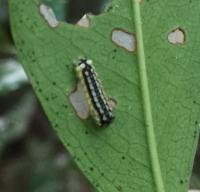Taxonomy
Superfamily:
Family: Subfamily: P3 Number: MONA Number:
Comments: Neoprocris floridana is one of only two species in this genus that occur in North America, and the only one that is found in North Carolina. Hall (2015) has an excellent detailed paper that covers the life history and ecology of this species, and is the basis for our species account.
Species Status: The larvae and adults of members of the Zygaenidae contain linamarin and lotaustralin, which are two compounds that can be taken in when the larvae feed on plants. These compounds can also be synthesized directly by some species. The compounds undergo enzymatic breakdown to release hydrogen cyanide (HCN) as a defense against predators (Hall, 2015). The toxic adults are frequently active during the day, and many are members of mimicry complexes.
Identification
Adult Markings: This is a medium-small moth with all body parts black, except for the abdomen and antennae that are black with an iridescent bright blue sheen (Hall, 2015). The antenna is bipectinate and tapers to a point, with the pectinations about twice as long in the males compared with the females. All of our other zygaenids -- including Harrisina americana and Acoloithus falsarius -- are similar but have yellow or orange markings on their thorax. Urodus parvula is also similar but has a smoky gray body and simple antennae.
Wingspan: 15-18 mm for males and 16-21 mm for females (Hall, 2015).
Immatures and Development: The larvae only feed on Carolina Laurel Cherry. The following life-history account is from Hall (2015) and is based on Florida populations that have three generations per year, with overwintering occurring in the pupal stage. The adults of the first seasonal generation emerge from overwintering pupae. The mated females lay large clusters of eggs on the undersides of young leaves near the leaf margins, and the hatchlings appear about 10 days later and skeletonize the leaf surfaces. The later instars switch from skeletonizing to feeding on leaf edges. When densities are high they may completely defoliate a branch or entire tree. The full-grown larvae spin cocoons on dead leaves in the litter beneath the host plants. The cocoons are flattened and oval-shaped, with the upper surface made of tough, densely spun silk. The larvae within cocoons secrete calcium oxalate monohydrate crystalline needles and incorporated these as small whitish clumps into the outer web-like layer of silk. The adults of the summer broods emerge soon after the larvae pupate and begin a new seasonal generation. Larvae from the final generation spin cocoons and pupate in leaf litter, and the pupae break winter diapause with the arrival of warmer spring weather.
Larvae ID Requirements: Identifiable from good quality photos, especially where associated with known host plants.

 »
»

 »
»